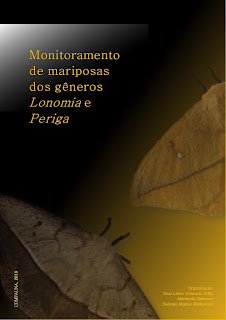Monitoramento de mariposas dos gêneros Lonomiae Periga
O livro apresenta aspectos gerais relacionados aos gêneros Lonomia e Periga, pertencentes à Família Saturniidae (Lepidoptera) e questões referentes às pesquisas ambientais que os envolvem. São discutidas características de investigações com finalidades ambientais e em saúde, incluindo uma galeria de imagens. Apresentam-se resultados de três avaliações ambientais realizadas no Paraná com o uso da Armadilha Curityba, envolvendo os gêneros Lonomiae Periga. Por fim, pontuam-se referências técnicas para monitoramentos ambientais e de saúde que envolvem os gêneros Lonomia e Periga.
Palavras-chave:
Lonomia, Periga, Lepidoptera, monitoramento, armadilha luminosa, ambiente, saúde
Monitoring of moths of the Lonomiaand Periga genera
The book displays several general aspects related to the Lonomia and Periga genera, which belong to the Saturniidae (Lepidoptera) Family and questions related to environmental researches that involve them. There is a discussion about characteristics of investigations with health and environmental finalities, including an image gallery. The results of three environmental evaluations carried out in Paraná with the use of the CuritybaTrap are shown, involving the Lonomia and Perigagenera. Finally, technical references for environmental and health monitoring which involve the Lonomia and Perigagenera are highlighted.
Key-words:
Lonomia, Periga, Lepidoptera, monitoring, luminous trap, environment, health.


